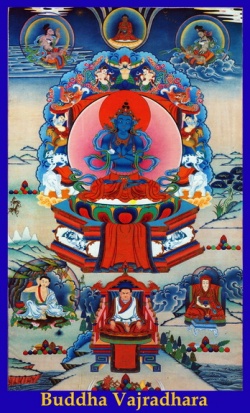The Golden Kagyu Garland
The 1000-year old Kagyu lineage originated with the great Indian mahasiddha Tilopa who lived around the 10th century CE. Tilopa is said to be self-realized as he received the highest teachings of the nature of mind directly from Vajradhara, the enlightened mind of the Buddha.
Tilopa also received and mastered special transmissions that he in turn passed to the Indian mahasiddha Naropa. These transmissions were systemized by Naropa as the six yogas of Naropa and are considered root practices of the Kagyu Lineage. Naropa transmitted his knowledge to the great Tibetan master Marpa the translator, who journeyed to India three times under great hardship in order to receive precious instructions from the Indian mahasiddhas. Marpa received the mahamudra teachings from mahasiddha Maitripa and combined the teachings of the six yogas of Naropa and mahamudra into one lineage. Marpa returned to Tibet where he widely spread the Dharma and is considered to be the father of the Kagyu Lineage.
Marpa's supreme disciple Milarepa became known as Tibet's greatest poet and one of its most beloved yogis. Through perseverance in the practice of mahamudra and the six yogas, Milarepa achieved enlightenment – the profound realization of the ultimate nature of reality in one lifetime.
Milarepa's transmission was continued by his most eminent student Gampopa, the physician from Dhagpo. Gampopa first studied the Kadampa tradition, the gradual path of mahayana mind training. Under Milarepa's guidance, Gampopa attained realization of the ultimate nature of reality. Gampopa established monastic institutions, taught extensively and attracted thousands of students. Gampopa’s major disciples founded what would be known as the four great and eight lesser schools of the Kagyu Lineage. The 1st Karmapa Dusum Khyenpa founded the Kamtsang Kagyu, also known as the Karma Kagyu Lineage.
The different Kagyu lineages are not referred to as major and minor in terms of the instructions they contain as they are equal in that respect. The four major lineages are known as major in that they originate with Gampopa himself, whereas the eight minor lineages originate with Gampopa's student, Phagmo Drupa. Of the four major Kagyu lineages the Karma Kagyu remains prevalent today. Among the eight minor Kagyu lineages only the Taglung, Drukpa and Drikung still exist as independent lineages.
The Golden Kagyu Garland refers to the masters who are the holders of the lineage in which mahamudra is a central teaching. This includes the Indian masters Tilopa and Naropa, the Tibetan forefathers Marpa, Milarepa and Gampopa and the successive reincarnations of the Karmapas and their most important students. The lineage holders of the Karma Kagyu are selected by the Karmapa himself, which ensures the teachings remain intact and pure.
